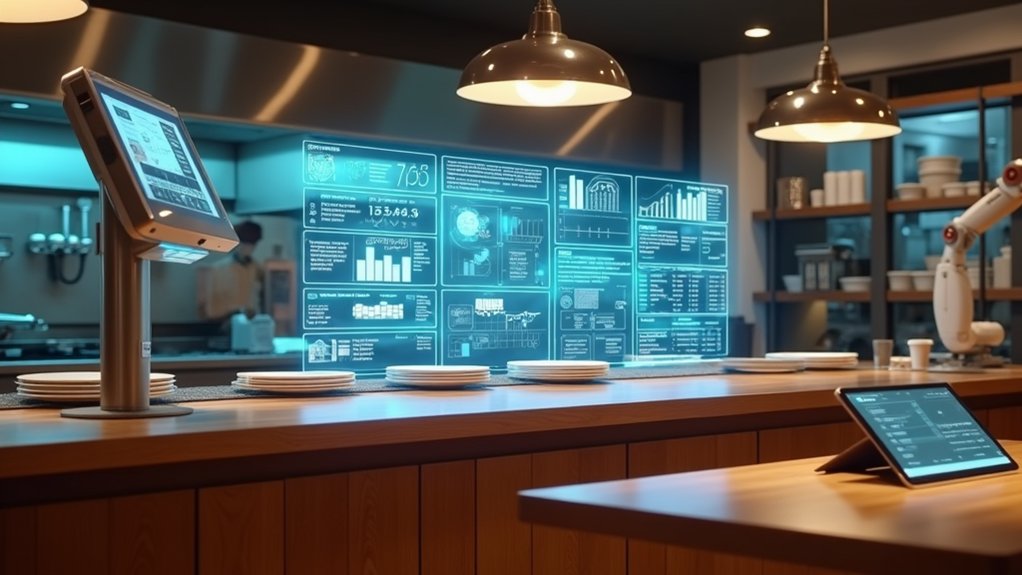In today’s competitive restaurant landscape, AI integration has become essential for small and medium-sized establishments to maintain their market position. While larger chains invest heavily in proprietary AI systems, independent restaurants can achieve similar efficiencies through strategic implementation of AI solutions. From streamlined ordering processes to intelligent staff scheduling and automated inventory management, these technologies level the playing field for smaller operators.
Professional AI integration transforms daily operations without compromising the personal touch that makes independent restaurants special. While the technology is readily available, proper implementation requires careful planning and expertise to optimize return on investment. Restaurants that partner with experienced specialists often see faster results and avoid costly implementation mistakes that can occur with self-guided adoption.
The key to successful AI integration lies not in replacing human elements, but in enhancing them – allowing staff to focus on creating memorable guest experiences while automated systems handle routine tasks. As the restaurant industry continues to evolve, those who strategically embrace AI with expert guidance position themselves for sustainable growth and increased profitability.
Key Takeaways
AI transformation has become essential for small and medium-sized restaurants to remain competitive in today’s digital-first market, where larger chains are rapidly adopting advanced technologies.
While enterprise restaurants invest heavily in proprietary AI systems, smaller establishments can achieve similar benefits through strategic implementation of existing AI solutions, guided by experienced integration specialists.
Professional AI implementation helps restaurants automate critical operations without disrupting existing workflows, ensuring smooth transition and staff adaptation. This approach minimizes common pitfalls and costly mistakes that often occur during self-implemented digital transformations.
The key to successful AI adoption lies not in the tools themselves, but in how they’re customized and integrated into a restaurant’s unique operational model. Expert guidance ensures that AI solutions align with specific business goals while maintaining the personal touch that makes independent restaurants special.
For sustainable growth, restaurants need more than off-the-shelf solutions – they need a comprehensive AI strategy that considers their market position, customer base, and long-term business objectives. This strategic approach helps preserve resources while maximizing return on technology investments.

As the restaurant industry evolves, artificial intelligence has become an essential tool for maintaining competitiveness, particularly for small and medium-sized establishments. While larger chains invest heavily in proprietary AI solutions, independent restaurants can achieve similar benefits through strategic AI implementation. Narrow AI solutions enhance daily operations without requiring extensive resources.
Professional AI integration enables restaurants to streamline operations across multiple fronts. From precise order management to intelligent staff scheduling, these technologies deliver measurable improvements in operational efficiency. Small restaurants particularly benefit from reduced errors, optimized workforce management, and enhanced customer service capabilities. Voice search technology is rapidly growing, with 27% of online users now using it to find restaurants. Research shows that forty-seven percent of restaurants currently utilize AI systems in their operations.
Customer engagement reaches new levels through AI-driven personalization and marketing automation. When properly implemented, these systems create meaningful connections with guests while respecting privacy concerns and maintaining the personal touch that defines independent restaurants. Implementation of 24/7 support through AI chatbots has become a crucial differentiator for modern restaurants.
While various off-the-shelf solutions exist, achieving optimal results requires careful consideration of a restaurant’s unique needs and circumstances. Professional guidance ensures seamless integration with existing systems, comprehensive staff training, and solutions tailored to specific business goals.
The return on investment becomes evident through multiple channels: reduced operational costs, improved customer satisfaction, and enhanced staff productivity. Small restaurants can particularly benefit from AI’s ability to minimize food waste and optimize inventory management – critical factors for maintaining healthy profit margins.
Though implementation challenges exist, they can be effectively managed through proper planning and expert guidance. The key lies in selecting and integrating solutions that complement, rather than replace, the human elements that make independent restaurants special.
For small and medium-sized restaurants, staying competitive in today’s market requires strategic adoption of AI technologies. Success depends not just on choosing the right tools, but on implementing them in ways that enhance rather than disrupt existing operations.
The future of restaurant operations lies in finding the perfect balance between technological efficiency and authentic hospitality. With proper guidance and implementation, AI becomes an invaluable asset in achieving this balance while maintaining the unique character of independent establishments.
Frequently Asked Questions
How Much Does It Cost to Implement AI Systems in a Restaurant?
Investing in AI systems for restaurants represents a strategic decision in today’s competitive hospitality landscape. While implementation costs vary based on business needs and scope, working with experienced AI integration specialists ensures optimal return on investment and seamless adoption.
Professional AI implementation encompasses crucial elements like operational analysis, customized solution design, and staff training. Rather than focusing solely on individual tools, successful AI integration requires a comprehensive approach that aligns with your restaurant’s specific goals and challenges.
In the current market, restaurants that delay AI adoption risk falling behind competitors who leverage these technologies to reduce costs, enhance customer experience, and streamline operations. The initial investment, typically ranging from $5,000 to $50,000+, delivers long-term value through improved efficiency, reduced waste, and data-driven decision-making.
Expert guidance through the AI implementation process helps restaurant owners avoid costly mistakes, ensure compliance, and maximize the technology’s potential while maintaining focus on their core business operations.
Monthly maintenance and support costs generally range between $200-$1,000, but these expenses are often offset by significant operational savings and increased revenue through optimized processes.
Can AI Systems Integrate With Existing Restaurant POS Software?
AI integration with restaurant POS systems represents a strategic advantage for small and medium-sized restaurants in today’s competitive landscape.
While many existing POS solutions offer AI capabilities, successful implementation requires careful planning and expertise.
Professional integration ensures seamless communication between AI systems and established POS software like Toast, Square, and Lightspeed. This preserves existing workflows while adding powerful automation features that larger chains already utilize.
Though AI technology has become more accessible, proper configuration and optimization demand specialized knowledge to maximize return on investment.
Strategic guidance helps restaurants identify the most impactful integration points without disrupting daily operations or overwhelming staff.
Rather than viewing AI as just another technology upgrade, forward-thinking restaurants treat it as a crucial business transformation that requires thoughtful implementation to gain and maintain competitive advantage in an evolving industry.
What Security Measures Protect Customer Data in AI Restaurant Systems?
Protecting customer data in today’s digital restaurant environment requires sophisticated AI security solutions that many small and medium-sized establishments struggle to implement independently.
While enterprise restaurants can afford dedicated IT teams, smaller venues need equally robust protection without the enterprise-level investment.
Modern AI-driven security systems create multiple protective layers through real-time monitoring, advanced encryption protocols, and intelligent threat detection – all working seamlessly in the background while restaurant staff focus on their core operations.
This level of protection has become essential, not optional, in maintaining customer trust and regulatory compliance.
For smaller restaurants, partnering with experienced AI integration specialists often proves more cost-effective than developing in-house solutions.
Professional implementation ensures proper configuration of security features, staff training protocols, and ongoing system maintenance – critical elements that determine the long-term success of any AI security infrastructure.
The restaurant industry’s increasing digitalization means that even small establishments must match their larger competitors in data protection capabilities.
Well-implemented AI security systems level the playing field, allowing independent restaurants to offer the same peace of mind as major chains while maintaining their unique, personal touch.
How Long Does Staff Typically Take to Learn AI Restaurant Technology?
The transition to AI restaurant systems represents a strategic investment in staying competitive in today’s digital-first market. While staff can generally grasp basic functions within 2-3 weeks, optimal implementation and full system mastery typically requires 1-2 months of dedicated attention.
Frontline operations like digital order-taking can be smoothly integrated within days, though advanced features such as predictive inventory management and data analytics require more thorough implementation planning and training.
Success rates in AI adoption largely correlate with proper initial setup and ongoing support. While tech-savvy team members may adapt more quickly, comprehensive onboarding ensures all staff members can effectively utilize these systems, regardless of their technical background.
Professional guidance during implementation helps restaurants avoid common pitfalls and accelerates the path to ROI.
Businesses that approach AI integration strategically, with expert support, consistently achieve faster adoption rates and better long-term results than those attempting to navigate the complexity alone.
This systematic approach helps protect the investment while ensuring smooth operational transition.
Do Customers Prefer Human Servers Over Ai-Powered Ordering Systems?
The evolving business landscape requires SMBs to carefully balance human interaction with technological efficiency. While traditional service models rely heavily on human staff, integrating AI-powered ordering systems has become essential for maintaining competitiveness and meeting modern customer expectations.
AI solutions offer SMBs critical advantages: consistent service quality, reduced operational costs, and increased efficiency during peak hours. These systems handle routine transactions flawlessly while allowing human staff to focus on creating meaningful customer relationships and handling complex situations that require emotional intelligence.
The implementation of AI technology requires strategic planning and expertise to ensure seamless integration with existing operations. Professional guidance helps businesses avoid costly mistakes, minimize disruption, and achieve optimal results that complement rather than replace human workers.
Small businesses that successfully blend AI capabilities with personalized service position themselves ahead of competitors, meeting both the efficiency demands of modern commerce and the emotional needs of their customers.
This balanced approach ensures sustainability and growth in an increasingly digital marketplace.









